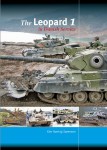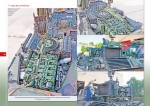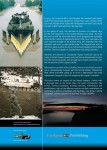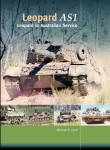Monday, May 18, 2020 - 08:00 AM UTC
Trackpad Publishing released three new titles, as well as reprinted a much anticipated older title. Check out the company's press release.
Model Foto Focus Series
Leopard 1A5(BE) – Belgium’s Last MBT Part 2
by Patrick Winnepenninckx
https://www.trackpadpublishing.com/belgian-1a5be
This book is the fifth in a series about the Leopard tank and its derivatives used by the Belgian Army. Previous books have looked at the Bergepanzer 2 and 2000 recovery vehicles, the Pionierpanzer engineer vehicle and the Leguan bridgelayer. Belgium was the first export customer for Leopard 1. In Part 1, we looked at the Leopard 1(BE) which played a major role in the story of this important European main battle tank. Here, in Part 2 we conclude the story with a thorough look at Belgium’s very last MBT, the Leopard 1A5(BE). We also examine the interior and powerpack, the Driver Trainer version, and the experimental MEXAS version. This Model Foto Focus takes a thorough look around these fascinating machines. For the modeller, this is the ultimate walkaround for an accurate model. For the armour enthusiast, it describes the very last Belgian main battle tank in great detail, looking at all details external
and internal.
A4, landscape, 104 pages, 389 photographs.
Trackpad Foto Album
Chieftain Down Range
by Peter Breakspear
https://www.trackpadpublishing.com/chieftain-down-range
Trackpad would like to introduce another new author. Peter Breakspear has a special interest in range wrecks and this is the first book from him on the subject. The format of the book is image heavy, letting the photos tell the stories of the fate of these vehicles.
The British Chieftain main battle tank was, without doubt, the master of the battlefield during its time. Today, it still serves on the ‘Battlefield’, but only as a target, helping to train the current generation of tank crews.
In this book, our search for Chieftain on live firing ranges does not just cover the United Kingdom but also crosses the Atlantic, visits a Mediterranean island, and also one of its former users in the Middle East. The images in this book deal with one vehicle type – the Chieftain and its variants. All the images capture a moment in time.
A4, landscape, 68 pages, 222 photographs.
Trackpad History Series Hardback book
The Leopard 1 in Danish Service
by Kim Hartwig Sørensen
https://www.trackpadpublishing.com/danish-leopard-1
This is a major 340-page work looking back over the whole career of the Leopard 1 from beginning to very near the end (some versions are still in service). It has been written by a former Danish Leopard 1 tank commander and an active officer of the Jutland Dragoon’s Regiment.
In 1953, the Centurion Mk.V tank became the standard main battle tank of the Danish tank squadrons. At that time, it was a modern tank, but in the middle of the 1960s the development of tanks had moved on, both in NATO and within the Warsaw Pact. In the spring of 1974, the decision to procure 120 Leopard 1A3s for the tank squadrons of the Jutland Division was made. The Cold War was on and the new tank would serve alongside the venerable Centurion for a while. At operational level in the 1970s and 1980s, the main wartime strength of the Danish Army was organised into five brigades, each with 40 main battle tanks. The Leopard tank was, at that time, solely used by the three mechanised brigades of the Jutland Division. The two brigades in Zealand were still using Centurion. However, the decision to completely replace Centurion had to be made so further Leopards were acquired from ex-Bundeswehr stocks. All of the Danish Leopards were brought up to modern standards with the introduction of the Leopard 1A5DK. Following the cessation of the Cold War, Denmark would take an active role in peacekeeping missions with the United Nations, followed by IFOR, SFOR and KFOR, going on to serve in Afghanistan with their replacement Leopard 2s but still supported by Leopard 1 variants.
This book covers all aspects of the Danish Leopard 1 family with a thorough look at the initial trials, the tank’s introduction into service, technical problems, training exercises, maintenance and modifications. Each of the different variants and their capabilities are examined, as well as camouflage and markings, crew dress, training equipment and the Leopard’s tactical and strategic mobility.
A4, portrait, hardback, 340 pages, over 1,400 photographs and diagrams.
Now Reprinted in Hardback
Trackpad History Series
Leopard AS1 – Leopard in Australian Service
by Michael K. Cecil
https://www.trackpadpublishing.com/leopard-as1
The first modern tank acquired by the Australian Army in the post-Second World War era was the Centurion, which began arriving in late 1951. The Centurion was a very formidable vehicle and was to remain in service for twenty-six years. Many were deployed operationally in South Vietnam from 1968 to 1971, where their firepower and armour undoubtedly helped in saving many Australian lives. By the early 1970s, however, the Centurions were becoming increasingly difficult to maintain in battle-worthy condition. A new, more modern tank would
need to be ready for service with the RAAC before the end of the 1970s. In 1974, following an exhaustive series of competitive trials between the M60A1 and
Leopard 1A1, the Australian government confirmed the purchase of the Leopard AS1 – in essence, a Leopard 1A3 with a unique suite of modifications to suit Australian requirements. A total of 103 vehicles were acquired, including MBTs, Bridgelayers and Armoured Recovery Vehicles, with the first arriving in Australia in late 1976. In March 2004, the decision was made to replace the Leopard with reconditioned US M1A1 Abrams. With the arrival of the Abrams in 2007, the Australian Leopards were withdrawn from service. Although never called upon to fire their guns in anger, they formed the armoured fist of the RAAC for thirty never-to-be-forgotten years.
This book covers all aspects of the Australian Leopard family with a thorough look at the initial trials, the tank’s introduction into service, technical problems, training exercises, maintenance and modifications. Each of the different variants and their capabilities are examined, as well as camouflage and markings, ammunition, crew dress, training equipment and the Leopard’s tactical and strategic mobility.
A4, portrait, hardback, 288 pages, over 800 photographs and diagrams.
Leopard 1A5(BE) – Belgium’s Last MBT Part 2
by Patrick Winnepenninckx
https://www.trackpadpublishing.com/belgian-1a5be
This book is the fifth in a series about the Leopard tank and its derivatives used by the Belgian Army. Previous books have looked at the Bergepanzer 2 and 2000 recovery vehicles, the Pionierpanzer engineer vehicle and the Leguan bridgelayer. Belgium was the first export customer for Leopard 1. In Part 1, we looked at the Leopard 1(BE) which played a major role in the story of this important European main battle tank. Here, in Part 2 we conclude the story with a thorough look at Belgium’s very last MBT, the Leopard 1A5(BE). We also examine the interior and powerpack, the Driver Trainer version, and the experimental MEXAS version. This Model Foto Focus takes a thorough look around these fascinating machines. For the modeller, this is the ultimate walkaround for an accurate model. For the armour enthusiast, it describes the very last Belgian main battle tank in great detail, looking at all details external
and internal.
A4, landscape, 104 pages, 389 photographs.
Trackpad Foto Album
Chieftain Down Range
by Peter Breakspear
https://www.trackpadpublishing.com/chieftain-down-range
Trackpad would like to introduce another new author. Peter Breakspear has a special interest in range wrecks and this is the first book from him on the subject. The format of the book is image heavy, letting the photos tell the stories of the fate of these vehicles.
The British Chieftain main battle tank was, without doubt, the master of the battlefield during its time. Today, it still serves on the ‘Battlefield’, but only as a target, helping to train the current generation of tank crews.
In this book, our search for Chieftain on live firing ranges does not just cover the United Kingdom but also crosses the Atlantic, visits a Mediterranean island, and also one of its former users in the Middle East. The images in this book deal with one vehicle type – the Chieftain and its variants. All the images capture a moment in time.
A4, landscape, 68 pages, 222 photographs.
Trackpad History Series Hardback book
The Leopard 1 in Danish Service
by Kim Hartwig Sørensen
https://www.trackpadpublishing.com/danish-leopard-1
This is a major 340-page work looking back over the whole career of the Leopard 1 from beginning to very near the end (some versions are still in service). It has been written by a former Danish Leopard 1 tank commander and an active officer of the Jutland Dragoon’s Regiment.
In 1953, the Centurion Mk.V tank became the standard main battle tank of the Danish tank squadrons. At that time, it was a modern tank, but in the middle of the 1960s the development of tanks had moved on, both in NATO and within the Warsaw Pact. In the spring of 1974, the decision to procure 120 Leopard 1A3s for the tank squadrons of the Jutland Division was made. The Cold War was on and the new tank would serve alongside the venerable Centurion for a while. At operational level in the 1970s and 1980s, the main wartime strength of the Danish Army was organised into five brigades, each with 40 main battle tanks. The Leopard tank was, at that time, solely used by the three mechanised brigades of the Jutland Division. The two brigades in Zealand were still using Centurion. However, the decision to completely replace Centurion had to be made so further Leopards were acquired from ex-Bundeswehr stocks. All of the Danish Leopards were brought up to modern standards with the introduction of the Leopard 1A5DK. Following the cessation of the Cold War, Denmark would take an active role in peacekeeping missions with the United Nations, followed by IFOR, SFOR and KFOR, going on to serve in Afghanistan with their replacement Leopard 2s but still supported by Leopard 1 variants.
This book covers all aspects of the Danish Leopard 1 family with a thorough look at the initial trials, the tank’s introduction into service, technical problems, training exercises, maintenance and modifications. Each of the different variants and their capabilities are examined, as well as camouflage and markings, crew dress, training equipment and the Leopard’s tactical and strategic mobility.
A4, portrait, hardback, 340 pages, over 1,400 photographs and diagrams.
Now Reprinted in Hardback
Trackpad History Series
Leopard AS1 – Leopard in Australian Service
by Michael K. Cecil
https://www.trackpadpublishing.com/leopard-as1
The first modern tank acquired by the Australian Army in the post-Second World War era was the Centurion, which began arriving in late 1951. The Centurion was a very formidable vehicle and was to remain in service for twenty-six years. Many were deployed operationally in South Vietnam from 1968 to 1971, where their firepower and armour undoubtedly helped in saving many Australian lives. By the early 1970s, however, the Centurions were becoming increasingly difficult to maintain in battle-worthy condition. A new, more modern tank would
need to be ready for service with the RAAC before the end of the 1970s. In 1974, following an exhaustive series of competitive trials between the M60A1 and
Leopard 1A1, the Australian government confirmed the purchase of the Leopard AS1 – in essence, a Leopard 1A3 with a unique suite of modifications to suit Australian requirements. A total of 103 vehicles were acquired, including MBTs, Bridgelayers and Armoured Recovery Vehicles, with the first arriving in Australia in late 1976. In March 2004, the decision was made to replace the Leopard with reconditioned US M1A1 Abrams. With the arrival of the Abrams in 2007, the Australian Leopards were withdrawn from service. Although never called upon to fire their guns in anger, they formed the armoured fist of the RAAC for thirty never-to-be-forgotten years.
This book covers all aspects of the Australian Leopard family with a thorough look at the initial trials, the tank’s introduction into service, technical problems, training exercises, maintenance and modifications. Each of the different variants and their capabilities are examined, as well as camouflage and markings, ammunition, crew dress, training equipment and the Leopard’s tactical and strategic mobility.
A4, portrait, hardback, 288 pages, over 800 photographs and diagrams.
Click Star to Rate
2 readers have rated this story.
THIS STORY HAS BEEN READ 2,480 TIMES.
| Trackpad Publishing Reviews | MORE |
| Leopard 1 in Danish Service by Paul Truhe | of 1 ratings, 100% found this helpful | |
| Tough Truck! by Mario Matijasic | |
| Battlegroup Leopard by Paul Truhe | |
| Belgian JPK90 by Paul Truhe | of 1 ratings, 100% found this helpful | |
| Danish Leopard in Afghanistan by Darren Baker | |
| Belgian Army Leopard 1 by Darren Baker | |
| Leopard 1(BE) by Paul Truhe | |
| Belgian CVR(T) Family Part 2 by Paul Truhe | |
| Belgian CVR(T) Family Part 1 by Paul Truhe | |
| IDF Shermans M-50 and M-51 by Adie Roberts | |
| IDF Jeeps by Adie Roberts | |
| History of the IDF Artillery 2 by Adie Roberts | |
| History of the IDF Artillery 1 by Adie Roberts | |
| Danish Leopards in Helmand by Brian O'Donoghue | |
| Biber Leopard 1 Bridgelayer by Brian O'Donoghue | |
































Comments